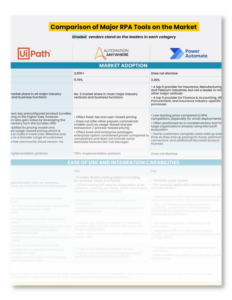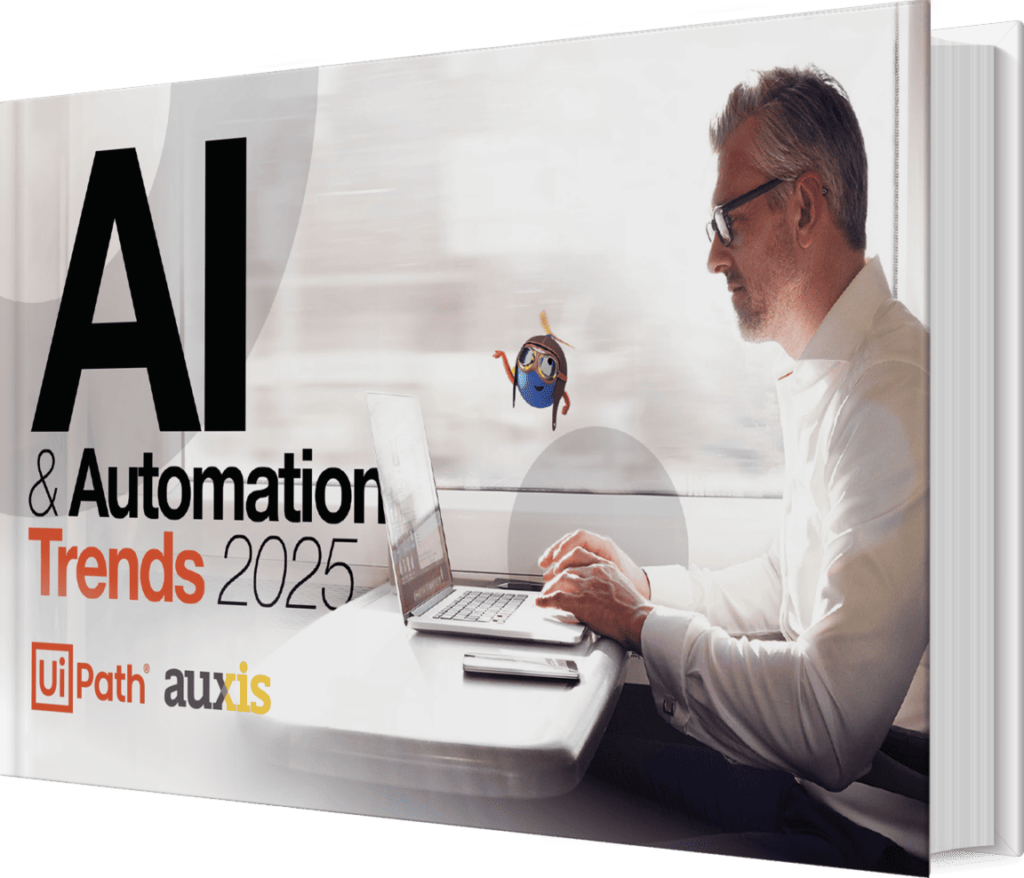In brief:
- Whether you’re starting a robotic process automation (RPA) journey or scaling to an automation-first enterprise, your needs are unique. Selecting a platform that matches your objectives and requirements is key to success.
- RPA software remains one of the fastest-growing software segments: IDC predicts RPA spending will more than double from 2024 to 2028 to reach $8.2 billion.
- UiPath continues to dominate the market of best RPA tools – ranking #1 in Gartner’s RPA vendor assessment for the sixth consecutive year and topping Everest Group’s RPA Products PEAK Matrix for the eighth, as the only Star Performer.
Robotic Process Automation (RPA) has long been the starting point for enterprise automation. Today, it’s evolving at an unprecedented pace with AI innovations like agentic automation and Generative AI (GenAI) – dramatically expanding what RPA can achieve.
The real question to consider is not if robotic process automation tools can benefit your business, but which ones are the best to suit your requirements and business objectives.
The needs of organizations looking to start an RPA journey are very different from those focused on becoming automation-first enterprises. Today’s RPA market is flush with different tools and platforms ranging from cost-effective, open-source tools to enterprise-grade, hyperautomation platforms offering scale, governance, and high impact.
To select the right platform, businesses must consider factors such as specific needs, budget, scalability, and ease of use. To help your research, this blog compiles the leading RPA tools for 2026 based on assessments from industry-leading advisory firms as well as our own analysis.
The evolution of RPA tools
For more than a decade, RPA has stood as a powerful tool for automating repetitive, rules-based manual tasks. Now, Generative AI and agentic automation are elevating its potential – extending intelligent automation tools far beyond what was possible before.
GenAI infuses RPA technology and other automation tools like Intelligent Document Processing (IDP) with intelligence, enabling bots to handle variations, exceptions, and unstructured data with far less manual intervention. Agentic automation takes it a step further: AI-powered agents can autonomously coordinate workflows, adapt to changes, make informed decisions, and execute complex, differentiated processes with minimal human oversight – all enhanced by machine learning capabilities.
RPA works in tandem with these AI advancements to optimize processes from start to finish: acting as the “muscle” for automating tasks while AI acts as the “brain.”
Together, these innovations not only change the way employees work – they change the very work they can do. Employees are freed from routine, mundane tasks and administrative burdens to focus on higher-value activities and complex tasks, businesses reduce costs and boost productivity, and organizations gain a competitive edge in a tight labor market.
Forward-thinking executives wield RPA software as a core tool for digital transformation – not only delivering its own benefits but enhancing other important initiatives like cloud platform, security, business intelligence, and more.
Even as AI advancements accelerate, RPA software remains one of the fastest-growing software segments: IDC predicts RPA spending will more than double from 2024 to 2028 to reach $8.2 billion.
What are the top RPA tools in the market?
In its latest assessment, Robotics Process Automation Products PEAK Matrix® Assessment 2024, Everest Group ranks the leading RPA providers as follows:
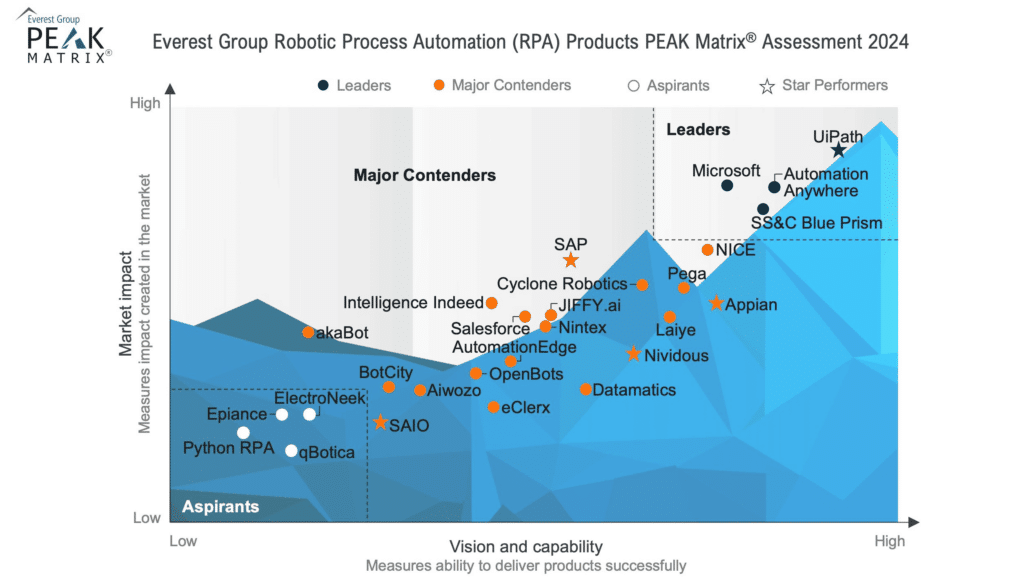
Everest groups RPA software providers into three main buckets based on market impact and ability to deliver products successfully.
UiPath is named a Star Performer for achieving the greatest year-over-year growth. It also reinforces its status as a Leader for the eighth consecutive year — claiming the matrix’s top spot once again.
Notably, Microsoft – the only other Star Performer alongside UiPath the previous year – did not earn the designation again in 2024, while UiPath’s closest pure-play rival, Automation Anywhere, missed the Star Performer ranking for the third consecutive year.
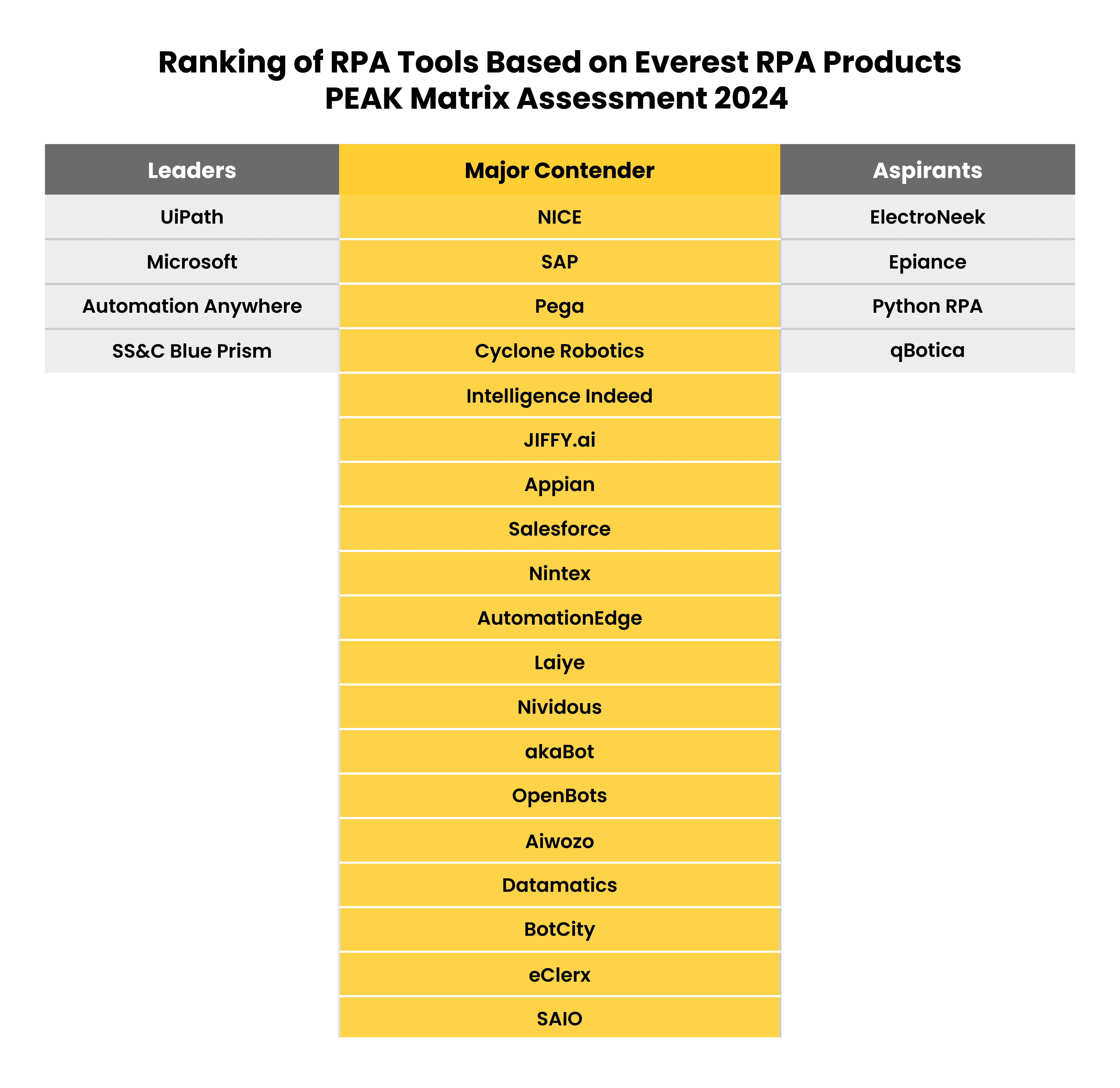
Everest Group isn’t alone in its assessment. In Gartner’s 2025 Magic Quadrant for RPA, UiPath claims the #1 spot for the sixth consecutive year. While Gartner awards second place to Automation Anywhere, Microsoft is a decisive #3 – outpacing SS&C Blue Prism not only there but in rankings by multiple top research firms.
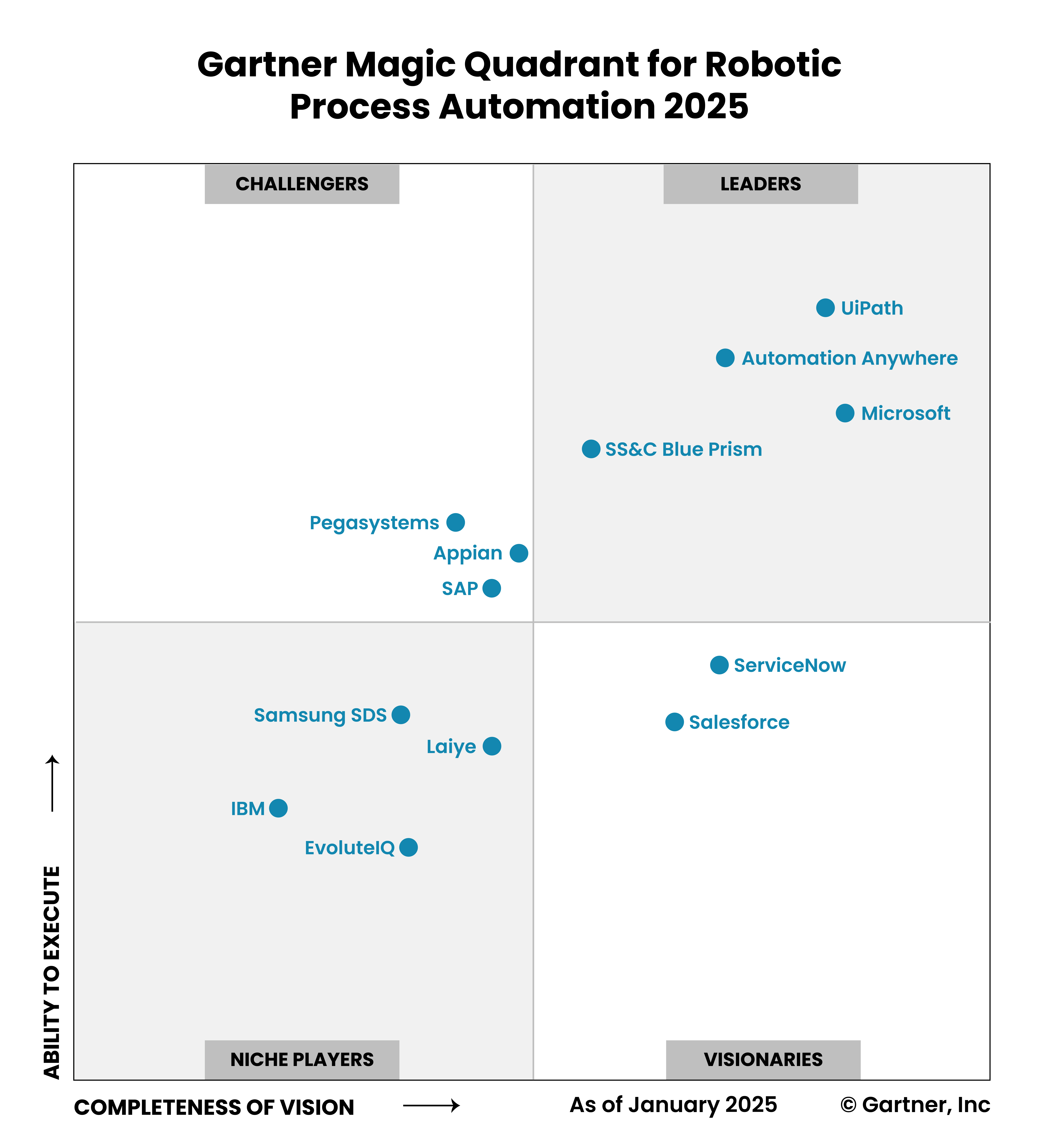
Below we compare the top tools for RPA and provide perspective on why UiPath gives you the most “bot for your buck.”
UiPath vs. other RPA tools
So, who are the top RPA companies?
- Founded in 2001, Blue Prism is credited with coining the term “Robotic Process Automation.” It was rebranded as SS&C Blue Prism after it was acquired by SS&C Technologies in 2022 for $1.6 billion.
- Automation Anywhere came next in 2003 as Tethys Solutions, officially rebranding to its current name in 2010.
- UiPath, founded by CEO Daniel Dines, originated in 2005 in Bucharest under the name DeskOver, focused on tech outsourcing and software development kits. It rebranded to UiPath in 2015 when entering the enterprise RPA market.
- Microsoft is a relatively late entrant to the RPA market. It started offering an RPA solution in 2020 as a built-in capability of its Power Automate platform, acquiring RPA software provider Softmotive in the same year.
The table below provides a quick snapshot of the best RPA software tools:
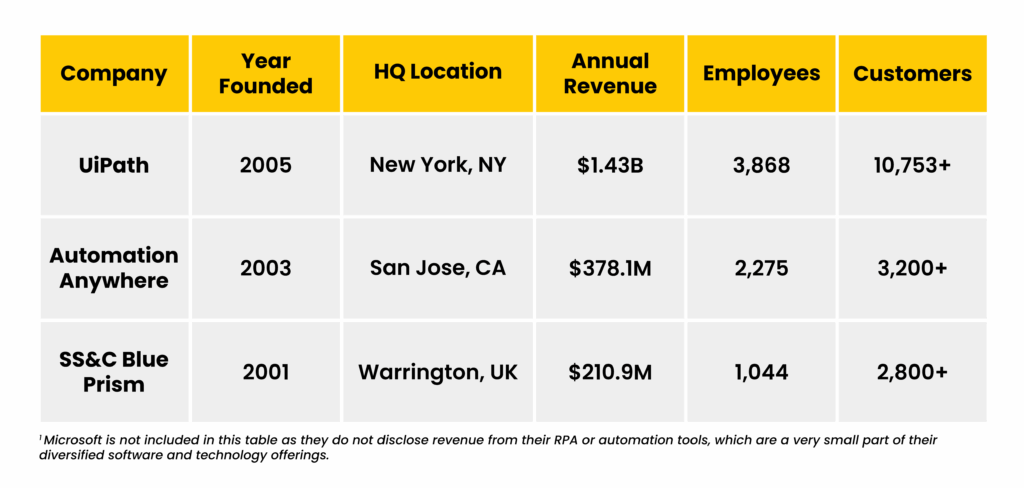
Blue Prism’s longer trajectory initially made it the go-to RPA solution. Most of its clients were large banking and financial institutions – among the only organizations that could afford the RPA technology’s initial high cost of entry.
Years later, more affordable competitors like UiPath and Automation Anywhere came to market with the same (or better) capabilities and increased flexibility and ease of implementation. As a result, RPA was “democratized” for companies of all sizes across many industries, including small and mid-market organizations.
Today, both UiPath and Automation Anywhere have significantly higher revenue streams than Blue Prism. Previously a publicly traded company, Blue Prism became a private entity after it was acquired by SS&C – shortly after facing a shareholder revolt and criticism over a perceived lack of investment in future products.
By comparison, UiPath launched one of the biggest and best software IPOs ever in 2021, with its stock rising 23% during its debut.
Despite Microsoft’s late entry into the RPA software market, it’s not surprising the software giant now ranks as an RPA leader in Everest’s and Gartner’s rankings. By bundling its RPA tool within its Power Automate platform – already used by more than 500,000 customers – Microsoft has rapidly driven adoption and kept users firmly within its ecosystem.
Offering discounts to Microsoft 365 Enterprise license holders further lowers the cost of RPA acquisition, making Power Automate an even more attractive choice. However, it works best within the Microsoft ecosystem, with users noting it can be difficult to integrate with non-Microsoft tools.
An interesting source for RPA tool comparisons is G2, which ranks the best RPA software and services based on real-time data from verified user reviews. UiPath is recognized on G2 as a Leader across small, mid-market, and enterprise customers.
As of September 2025, the top RPA platforms were rated as follows on G2:
- UiPath: 4.6/5 with 7,085 reviews
- Automation Anywhere: 4.5/5 with 5,524 reviews
- SS&C Blue Prism: 4.5/5 with 401 reviews
- Microsoft Power Automate: 4.4/5 with 782 reviews
What makes UiPath the top-rated RPA tool?
UiPath’s market leadership extends well beyond rankings. It’s the largest vendor by RPA-specific revenue, serving more than 10,000 enterprise customers (including over 5,000 dedicated RPA clients) – more than any other pure-play intelligent automation provider. And it consistently delivers above-market growth on its already substantial revenue base.
UiPath’s enterprise-grade RPA solution also continues to increase its dominant market share each year. It demonstrates an exceptional ability to retain customers and increase their spending over time, reporting an impressive 121% dollar-based net retention rate.
Users cite UiPath’s biggest strengths as its user-friendly interface, ease of setup and implementation, robust customer support, and the RPA platform’s ability to streamline automation processes and enhance efficiency. Clients also value UiPath’s vision for intelligent automation, robust governance features, comprehensive product suite, and its intuitive drag and drop interface that simplifies building automations.
On Everest’s RPA assessment, UiPath ranks highest for market adoption, portfolio mix, vision and strategy, deployment and maintenance, and product training and support. It also has the highest market share in most industry verticals and across geographies.
Everest credits UiPath’s sustained RPA Leader status to its Generative AI-powered capabilities, seamless integration with continuous discovery tools such as process mining, industry-tailored solutions, robust ecosystem of custom and prebuilt integrations, and strong commitment to customer training and support.
Gartner emphasizes UiPath’s distinctive product strategy, built around leveraging GenAI to enhance its RPA platform. Key features include natural-language-driven automation development and advanced self-healing during runtime, positioning UiPath as a compelling choice for AI-augmented automation.

Key advantages offered by UiPath RPA
Implementing UiPath RPA offers many distinctive advantages, including:
- Support for the full automation lifecycle, from discovery to measurement. UiPath continues to add capabilities that enhance its RPA offering, including app development, agentic orchestration, intelligent xtraction & processing, communications mining, test automation, embedded analytics, API integrations, and more.
- One of the only enterprise-grade agentic orchestration platforms – uniting RPA, AI agents, AI models, and people to drive productivity and better outcomes. UiPath’s framework integrates across systems and tools, ensuring reliable execution, robust governance, and human-in-the-loop for critical decisions.
- Leveraging Generative AI constructed on large foundational models, Specialized AI built for specific business tasks, and advanced machine learning techniques, UiPath offers cutting-edge AI capabilities that enable robust, scalable, and customized solutions for automating complex business processes while securely handling customer data.
- Autopilot for Everyone – an artificial intelligence companion that discovers, runs, connects, and can even create automations to handle complex, end-to-end tasks autonomously, from expense report submissions to uncovering sales leads.
- AI-powered Healing Agent that brings true self-healing to automation – detecting and helping to fix bot failures in real time, reducing downtime, and freeing developers for higher-value work. Combined with its agentic automation framework, this new advancement helps UiPath deliver the industry’s most resilient and adaptive automation platform.
- Free community edition creates an entry-level opportunity for small and mid-sized businesses, helping them create production-ready RPA without significant upfront investments. None of the other RPA leaders offer anything similar, making UiPath’s solution uniquely attractive to smaller businesses and citizen developers.
- Free, self-paced, instructor-led training in a variety of languages tailored to different personas like professional developers, citizen developers, and business users. UiPath also offers a large online community of users for collaboration and knowledge sharing.
- Best combination of attended and unattended automation, standing out from the many platforms designed primarily for attended automation.
- Available as both a SaaS solution and on-premise. Many providers, like Microsoft, only support RPA orchestration in-cloud.
Scaling automation: the biggest battle to win
Helping organizations successfully scale their RPA programs remains one of the biggest priorities – and challenges – for RPA software vendors and implementation partners alike. Many still struggle to identify the right use cases, build a strategic roadmap, and implement effectively to achieve speed and expected ROI.
When done right, RPA is transformational – but selecting the right platform and partner is critical to making that happen. As a top 2% UiPath partner – combining recognitions as a Platinum Partner, Agentic Automation Fast Track Partner, and Partner of the Year – Auxis brings a proven record of delivering measurable AI and automation success.
Our onshore and nearshore delivery model sets us apart from other providers – offering real-time collaboration, cost-effectiveness, and a deep bench of UiPath-certified automation talent spanning Latin America’s top tech hubs. Our exclusive focus on UiPath also accelerates results, enabling deep expertise and optimal solutions that generalist providers can’t match.
With revolutionary advancements like GenAI and agentic automation reshaping the future of work, implementing UiPath with Auxis gives your business the expertise, scale, and innovation needed to turn potential into reality.
To schedule a consultation on how Auxis can support you in your RPA journey, click here. To read more about Auxis’ UiPath capabilities and some of Auxis’ RPA client case studies, click here. You can also download our Robotic Process Automation Tools Checklist for a feature-by-feature comparison of the top tools.
Frequently Asked Questions
1. What are the best RPA tools for 2026?
2. Why is UiPath considered the top RPA tool?
3. What factors should I consider when choosing tools for RPA?
4. What are the pros and cons of UiPath vs. other RPA tools?
5. How quickly can I deploy UiPath in my organization?


